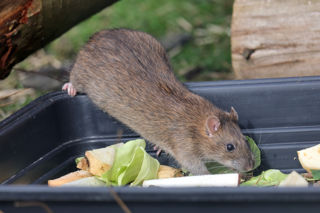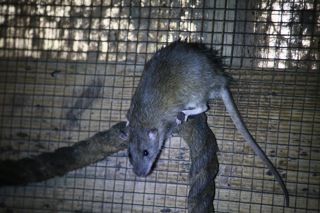
Brown Rat
Rattus norvegicus
Brown rats have coarse fur which can vary from brown to dark grey, with much lighter underside. They are large rodents weighing between 200-400g (almost double that of the black rat). Compared to the black rat, it has a larger, sturdier body. Its tail is shorter than the rest of its body, and it has small ears and eyes, and a slanted nose.
Habitat
They are present wherever humans are, mainly in cooler climates. This can range from urban areas, coastal, woodland and arable land.
Behaviour
They are nocturnal, living in small family groups within a colonial structure. Hierarchies are present based on age and size. “Huddling” behaviour is key for their social nature, manifesting first as young pups that depend on heat from their mother to thermoregulate. Rats burrow extensively bother for shelter and food storage, but also for thermoregulated nest sites. Breeding occurs throughout the year, with the gestation period only being 21 days and sexual maturity being reached at 5 weeks of age.
Family facts
Female rats can become pregnant immediately after giving birth; nursing one litter while pregnant with another. It's no surprise that it is regarded as the most successful mammal on the planet alongside humans.
They spend a lot of time grooming both themselves and other rats. Despite their reputation, they are extremely clean!

Distribution
Global distribution, being found anywhere humans are found. The only rat-free areas in the world are Antarctica, isolated islands, some areas of New Zealand and Alberta, Canada.
Diet
Omnivore, consuming almost anything.
UK Status
Thought to have been introduced to UK in 1720. Currently found throughout the country, including some Scottish islands. Only really absent from exposed mountainous regions.
Threats
There are no real threats to this species.


